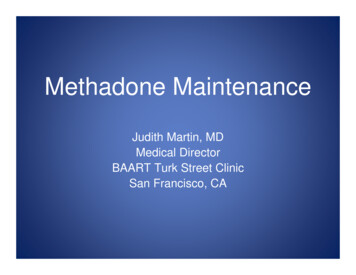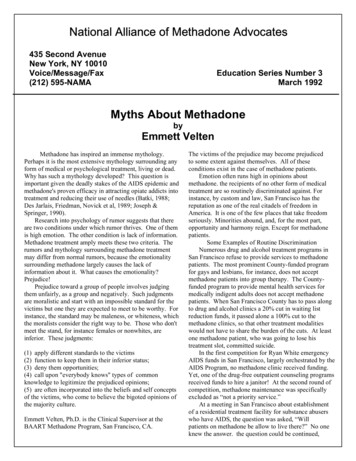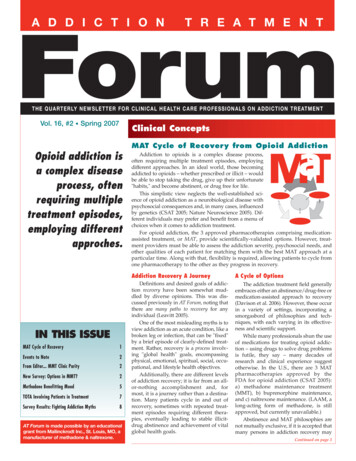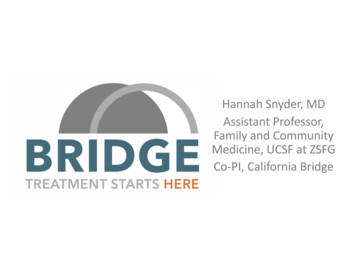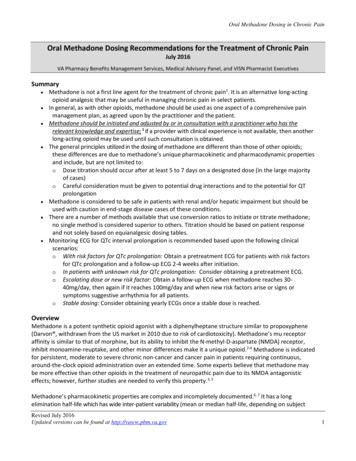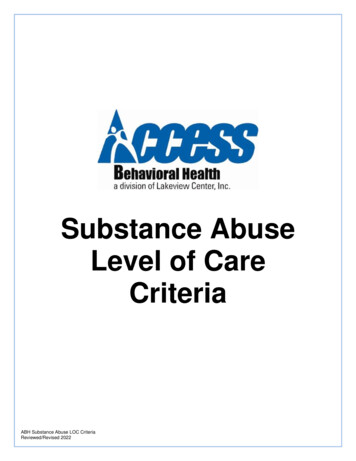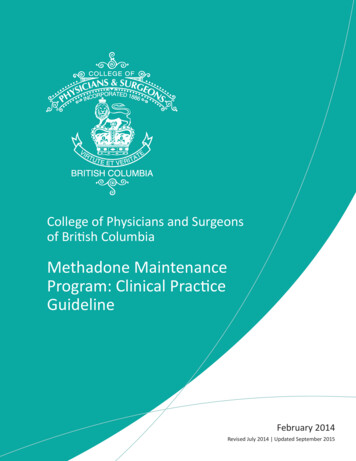
Transcription
College of Physicians and Surgeonsof British ColumbiaMethadone MaintenanceProgram: Clinical PracticeGuidelineFebruary 2014Revised July 2014 Updated September 2015
Methadone Maintenance Program: Clinical Practice GuidelineCONTENTSPreface . 1Introduction . 21.The History of Methadone . 22.Authorization to Prescribe Methadone . 23.2.1Full Authorization . 32.2Temporary Authorization . 42.3Hospitalist Authorization. 4Pharmacology of Methadone . 43.1Absorption . 53.2Duration of Action/Metabolism . 53.3Tolerance . 5Admission to the Methadone Maintenance Program . 61.Criteria for Admission to the Methadone Maintenance Program . 62.DSM-IV-TR Diagnostic Definition of Opioid Use Disorder . 73.Treatment Considerations . 83.1Detoxification . 83.2Outpatient and Day Treatment Programs. 83.3Residential and Support Recovery Programs . 83.4Alternative Pharmacotherapies . 83.5Mutual Support Groups. 93.6Mental Health Services. 9Assessment for Initiation . 101.Assessment Checklist . 102.Treatment Goals and Plans . 113.Problematic Alcohol Use . 114.Process (Behavioural) Addictions . 12College of Physicians and Surgeons of British ColumbiaSeptember 2015i
Methadone Maintenance Program: Clinical Practice GuidelineContentsMaintenance and Monitoring . 141.2.3.Methadone Dosing . 141.1Initiation (Induction). 141.2Titration . 151.3Stabilization . 161.4Split Doses . 161.5Missed Doses . 171.6Dosing Precautions . 185.1.6.2Toxicity . 191.6.3Fatal Overdoses . 192.1When and Why to Order UDT . 202.2Method of Collection. 202.3Urine Toxicology . 20Carry Privileges . 22Criteria for Initiating Methadone Carries . 223.1.1Biopsychosocial Stability . 223.1.2Safe Methadone Storage. 223.2Carry Schedule. 233.3Exceptions to Carry Guidelines. 233.4Prescriptions for Carries . 233.5Reassessment of Carry Privileges . 23Counselling . 244.1The Methadone Prescriber’s Role . 244.2Brief Interventions. 254.3Transtheoretical Model of Change . 264.4Community Substance Use Services. 26Documentation of Benefits . 275.16.Side Effects of Methadone . 18Urine Drug Testing (UDT) . 203.14.1.6.1Categories of Benefits . 27Prescriptions for Methadone Maintenance . 28College of Physicians and Surgeons of British ColumbiaSeptember 2015ii
Methadone Maintenance Program: Clinical Practice GuidelineContentsDiscontinuation of Methadone Maintenance Treatment . 301.Discontinuation in Stable Patients: Treatment Goals Achieved . 302.Discontinuation in Unstable Patients: Treatment Goals Not Achieved . 313.Involuntary Dismissal . 314.Transfer of Care. 31Advice to Physicians Downsizing or Leaving Their MethadoneMaintenance Practices . 33Special Populations . 341.Introduction . 342.Adolescent Patients. 343.Women of Child-Bearing Potential . 354.Pregnant Women . 354.1Introduction. 354.2Guiding Principles . 374.3Management . 384.3.1Initial Assessment . 384.3.2Prenatal Management. 384.3.3Third Trimester . 394.3.4Intrapartum . 394.3.5Postpartum . 394.3.6Breastfeeding and Methadone . 404.3.7Urine Drug Testing (UDT) . 404.3.8Prenatal Methadone Withdrawal Management . 404.3.9Neonatal Abstinence Syndrome (NAS). 414.3.10 Child Protection . 415.Patients with Comorbid Conditions . 425.1Hepatitis C . 425.1.15.2Management issues . 42HIV/AIDS . 43College of Physicians and Surgeons of British ColumbiaSeptember 2015iii
Methadone Maintenance Program: Clinical Practice Guideline5.2.15.3Management Issues . 43Mental Health Issues – Concurrent Disorders. 435.3.15.4ContentsManagement Issues . 44Polysubstance Comorbidity . 445.4.1Management Issues . 446.Hospitalized Patients . 457.Provincial and Federal Corrections Facilities . 467.17.28.Provincial Corrections Facilities. 467.1.1Initiation of Methadone Maintenance Treatment . 477.1.2Drug Treatment Court of Vancouver. 47Federal Corrections Facilities . 47Patients Who Wish to Travel. 47Methadone and Pain. 49College of Physicians and Surgeons of British ColumbiaSeptember 2015iv
Methadone Maintenance Program: Clinical Practice GuidelinePREFACEThe College of Physicians and Surgeons of British Columbia, with the clinical advice of the College’sMethadone Panel of the Quality Assurance Committee, administers the Methadone MaintenanceProgram in British Columbia under the authority of the Health Professions Act (HPA) and the Bylawsunder the HPA, and in accordance with Health Canada’s Drug Strategy and Controlled SubstancesProgramme.Methadone Maintenance Program (MMP)The objective of the Methadone Maintenance Program (MMP) is to assist physicians in safely andeffectively prescribing methadone for opioid dependence.The MMP assists physicians in the following ways: developing guidelines for safe and effective prescribing of methadone for opioid dependenceproviding education including workshops on prescribing methadone for opioid dependencefacilitating preceptorships for physicians who wish to prescribe methadone for opioiddependenceconducting peer practice assessments (PPAs) of the physicians who are authorized to prescribemethadonemaintaining a central registry of methadone prescribers and registered patientsmaking recommendations to the federal Ministry of Health regarding physicians’ authorizationsMethadone Maintenance Program: Clinical Practice GuidelineThis guideline addresses the prescribing of methadone for the treatment for opioid dependence—physicians prescribing methadone for analgesia (both for palliative and chronic non-cancer pain) shouldrefer to the handbook Recommendations for the Use of Methadone for Pain.These clinical guidelines are evidence-based, represent the expert opinion of the Methadone Panel, andare intended for physicians in British Columbia who are prescribing methadone for opioid dependence.Physicians should exercise careful clinical judgment when considering whether it is appropriate todeviate from these guidelines. Any deviations should be documented in patients’ medical records,together with the rationale for those decisions.College of Physicians and Surgeons of British ColumbiaSeptember 20151
Methadone Maintenance Program: Clinical Practice GuidelineINTRODUCTION1.The History of MethadoneMethadone was discovered in 1938 by two German scientists, Max Bockmühl and Gustav Ehrhart, andwas patented in September 1941. Bockmühl and Ehrhart were attempting to find a gastrointestinal tractantispasmodic and analgesic which would be structurally dissimilar to morphine, non-addictive, andwould escape the strict legal controls placed on opioids at that time. In 1947, Harris Isbell and hiscolleagues, who had been experimenting extensively with methadone, discovered that methadone wasbeneficial in the treatment of opiate-dependent patients. 1Several studies from the United Kingdom in the 1940s described methadone’s efficacy in reducingheroin withdrawal symptoms. Ingeborg Paulus and Dr. Robert Halliday, working with the NarcoticAddiction Foundation in Vancouver, established the first methadone maintenance treatment program inthe world and published their findings in the Canadian Medical Association Journal in 1967. 2 In theUnited States, Dr. Vincent Dole and Dr. Marie Nyswander confirmed the feasibility of using methadoneas a maintenance medication for heroin dependence. 3 Since then, many other studies have shown theeffectiveness of using methadone as a maintenance medication for opioid dependence. These studiesdemonstrate a three- to four-fold increase in death rates in patients discontinuing methadonemaintenance treatment. 4,5 In addition to physical, mental and social health benefits, studies haveconsistently shown that risk of blood-borne pathogen transmission is significantly reduced byparticipation in methadone maintenance treatment, even in patients failing total abstinence from illicitsubstances. 62.Authorization to Prescribe MethadoneMethadone is a controlled drug and physicians who wish to prescribe methadone in Canada requireauthorization in the form of an exemption from the federal minister of health, in accordance withsection 56 of the Controlled Drugs and Substances Act. Physicians must apply to the MethadoneMaintenance Program at the College of Physicians and Surgeons of British Columbia for this exemption.1Isbell H, Wikler A, Eddy NB, Wilson JL, Moran CF. Tolerance and addiction liability of 6-dimethylamino-4-4-diphenylhyptanone-3 (methadon). J Am Med Assoc. 1947 Dec 6;135(14):888–94.2Paulus I, Halliday R. Rehabilitation and the narcotic addict: results of a comparative methadone withdrawal program. Can MedAssoc J. 1967 Mar 18;96(11):655-9.3Dole VP, Nyswander ME. A medical treatment for diacetylmorphine (heroin) addiction: a clinical trial with methadonehydrochloride J Am Med Assoc. 1965;193:646-50.4Bell J and Zador D. A risk-benefit analysis of methadone maintenance treatment. Drug Saf, 2000 Mar; 22(3):179-90.5Humeniuk R, Ali R, White J, Hall W, Farrell M. Proceedings of expert workshop on the induction and stabilisation of patientsonto methadone. Monograph 39. Adelaide: Commonwealth Department of Health and Aged Care; 2000.6Leshner AI. Science-based views of drug addiction and treatment. JAMA. 1999;282(14):1314–16.College of Physicians and Surgeons of British ColumbiaSeptember 20152
Methadone Maintenance Program: Clinical Practice GuidelineIntroductionThe College then recommends and forwards physicians’ names to Health Canada to be considered forapproval.The words “exemption” and “authorization” both refer to the exemption which is granted under section56 of the Controlled Drugs and Substances Act and which authorizes a physician to prescribemethadone.Physicians can apply for one of three types of authorizations to prescribe methadone for opioiddependence: full, temporary or hospitalist.2.1Full AuthorizationThe College will recommend a full authorization to Health Canada only after the following requirementshave been satisfactorily fulfilled: attendance at the Methadone 101 Workshop sponsored by theCollegea completed Application for Authorization to Prescribe Methadonein the Treatment of Opioid Dependencefamiliarization with the Methadone Maintenance Program: ClinicalPractice Guidelinea preceptorship satisfactory to the MMPan acceptable review of your prescription profile from thePharmaNet databasean interview with a member of the registrar staffan agreement to undertake a minimum of 12 hours of continuingmedical education (CME) in addiction medicine each yearan agreement to provide after-hours contact information regardingyour methadone maintenance patientsan agreement to undergo a practice assessment of your methadonemaintenance practice within the first yearContact theMethadoneMaintenanceProgram for a listof approvedpreceptors.The initial authorization is provisional and granted for one year. Continued support for this authorizationis contingent upon satisfactory peer practice assessments and acceptable reviews of the prescriber’sPharmaNet practitioner prescription profile. (The Renewal/Cancellation of Methadone Authorizationform and the Physician’s Contact Information form are available on the College website under the BCMethadone Program page.)College of Physicians and Surgeons of British ColumbiaSeptember 20153
Methadone Maintenance Program: Clinical Practice Guideline2.2IntroductionTemporary AuthorizationA temporary authorization to prescribe methadone for up to 60 days can be obtained in the followingcircumstances: locum replacement of another authorized physician (advance notice required)continuation of methadone prescribing for patients in hospital when no other authorizedphysician is availableA completed application for either a Temporary Authorization to Prescribe Methadone as a Locum in aClinic or Correctional Centre or a Temporary Authorization to Prescribe Methadone in a Hospital isrequired.Physicians with temporary authorizations may not initiate patients on methadone treatment for opioiddependence and should exercise caution and consider consulting more experienced prescribers ifincreasing doses.2.3Hospitalist AuthorizationPhysicians caring for methadone patients in a hospital setting may apply for a hospitalist methadoneauthorization after satisfactorily fulfilling the following requirements: attendance at the Methadone 101/Hospitalist Workshop sponsored by the Collegea completed Application for Authorization to Prescribe Methadone as a Hospitalistfamiliarization with the Methadone Maintenance Program: Clinical Practice Guidelinefamiliarization with the recommended key articles on methadone for analgesiafamiliarization with the Recommendations for the Use of Methadone for Painan interview with a member of the registrar staffan acceptable review of your prescription profile from the PharmaNet databaseThis authorization includes a full authorization to prescribe methadone for analgesia and a limitedauthorization to prescribe methadone for opioid dependence, which does not include registeringpatients in the Methadone Maintenance Program unless their continuity of care with a communitymethadone prescriber is arranged prior to their discharge. Please also refer to Hospitalized Patients.3.Pharmacology of MethadoneMethadone is a long-acting synthetic opioid which as an oral formulation is effective in treating opioiddependence. It is primarily a mu ( ) opioid receptor agonist and when administered in an adequatedose, it will prevent opioid withdrawal, reduce opioid craving and block the euphoric effects of opioidssuch as heroin.College of Physicians and Surgeons of British ColumbiaSeptember 20154
Methadone Maintenance Program: Clinical Practice Guideline3.1IntroductionAbsorption 3.2Oral methadone is 80–95% bioavailable compared to only 30% for oral morphine.Methadone is rapidly absorbed following oral administration and serum levels are detectable 30minutes post dose.Duration of Action/Metabolism 3.3The time to peak plasma concentration and peak clinical effect isfour hours (range of two to six hours).The plasma half-life averages 24 to 36 hours at steady state, butranges from four to 90 hours.As a result of its long half-life, methadone may accumulate, leadingto sedation and respiratory depressionIt takes four to five days for methadone plasma levels to reachsteady state after each dose change.Methadone metabolism is primarily a function of liver enzymeactivity involving cytochrome P450 isoforms. There are manysubstances that interact by inducing, inhibiting or acting as asubstrate for these enzymes. This can result in clinically significantdrug interactions. Genetic, physiologic and environmental factorscan also act on these enzymes, leading to a high degree of variationof individual methadone responsiveness.Methadone is primarily excreted as an inactive metabolite (10% asunchanged methadone) primarily in urine and feces. Compromisedrenal function does not preclude the use of methadone, and thedosage does not need to be adjusted for patients on dialysis.Elimination half-life is approximately 22 hours, but ranges from fivehours to 130 hours.A list ofmedicationsmetabolized bycytochrome P4503A4 is availablehere.Tolerance Cross-tolerance between methadone and other opioids is unpredictable.Tolerance to the various effects of methadone develops at different rates. Tolerance to theeuphoric effects of methadone develops quickly and may be interpreted by patients as beingdue to an inadequate dose. Tolerance to respiratory depression is less rapid in onset andtolerance to the autonomic side effects is the slowest.Tolerance is lost in as little as three days.Methadone is potentially lethal and the risk of toxicity is increased by concomitant ingestion ofalcohol and sedative-hypnotics such as benzodiazepines and Z drugs.College of Physicians and Surgeons of British ColumbiaSeptember 20155
Methadone Maintenance Program: Clinical Practice GuidelineADMISSION TO THE METHADONE MAINTENANCEPROGRAM1.Criteria for Admission to the Methadone MaintenanceProgramAll patients being prescribed methadone for maintenance (opioid dependence) must be registered inthe Methadone Maintenance Program (MMP) which is administered by the College of Physicians andSurgeons of British Columbia by agreement with the British Columbia provincial government. After anauthorized methadone prescriber has assessed a patient as an appropriate candidate for methadonemaintenance treatment (MMT) and has formulated a treatment plan with that patient, the patientshould be registered with the Methadone Maintenance Program before MMT is initiated (unless theMMT is initiated in hospital, when the registration may be deferred until their discharge to thecommunity).For admission to the program the patient must meet the following inclusion criteria: meet DSM-IV-TR criteria for opioid dependence (the panel opted to continue using DSM-IV-TRcriteria due to the large body of literature supporting clinical outcomes using these criteria)have experienced adverse consequences in multiple life realmshave undergone a documented and comprehensive evaluation to determine the risks andbenefits of methadone and other treatment optionshave documented initial goals of treatmentbe informed of all other treatment options for opioid dependence so that their decision to startMMT is based on valid informed consentThese forms are available for your use: MMP Patient Assessment FormMethadone Maintenance Treatment Agreement and ConsentPatient RegistrationPatient TransferFamily Physician NotificationMethadone prescribers should not hesitate to seek a second opinion when dealing with difficultmanagement problems such as patients with chronic pain, adolescents, pregnant patients and patientswith polydrug dependence. See Special Populations for more information.College of Physicians and Surgeons of British ColumbiaSeptember 20156
Methadone Maintenance Program: Clinical Practice Guideline2.Admission to the Methadone Maintenance ProgramDSM-IV-TR Diagnostic Definition of Opioid Use DisorderOpioid dependence, as a type of substance dependence, is defined as follows:A maladaptive pattern of substance use, leading to clinically significant impairment or distress, asmanifested by three (or more) of the following, occurring at any time in the same 12-month period:1. Tolerance, as defined by either of the following:a. A need for markedly increased amounts of the substance to achieve intoxication ordesired effectorb. Markedly diminished effect with continued use of the same amount of the substance2. Withdrawal, as manifested by either of the following:a. the characteristic withdrawal syndrome for the substance (refer to criteria A and B ofthe criteria sets for withdrawal from the specific substances)orb. the same (or a closely related) substance is taken to relieve or avoid withdrawalsymptoms3. The substance is often taken in larger amounts or over a longer period than was intended4. There is a persistent desire or unsuccessful efforts to cut down or control substance use5. A great deal of time is spent in activities necessary to obtain the substance (e.g., visitingmultiple doctors or driving long distances), use the substance (e.g., chain-smoking), orrecover from its effects6. Important social, occupational, or recreational activities are given up or reduced because ofsubstance use7. The substance use is continued despite knowledge of having a persistent or recurrentphysical or psychological problem that is likely to have been caused or exacerbated by thesubstance (e.g., current cocaine use despite recognition of cocaine-induced depression, orcontinued drinking despite recognition that an ulcer was made worse by alcoholconsumption)Reprinted with permission from the Diagnostic and Statistical Manual of Mental Disorders, TextRevision, Fourth Edition (Copyright 2000). American Psychiatric Association.College of Physicians and Surgeons of British ColumbiaSeptember 20157
Methadone Maintenance Program: Clinical Practice Guideline3.Admission to the Methadone Maintenance ProgramTreatment ConsiderationsIt is recommended that MMT be part of a spectrum of treatment focused on improving health and socialoutcomes. Because the majority of MMT patients are polysubstance dependent, it is important forphysicians prescribing methadone to be aware of, and familiar with, a broad range of other treatmentresources. The proble
Methadone Maintenance Program: Clinical Practice Guideline College of Physicians and Surgeons of British Columbia 2 September 2015 INTRODUCTION 1. The History of Methadone Methadone was discovered in 1938 by two German scientists, Max Bockmühl and Gustav Ehrhart, and was patented in September 1941.


